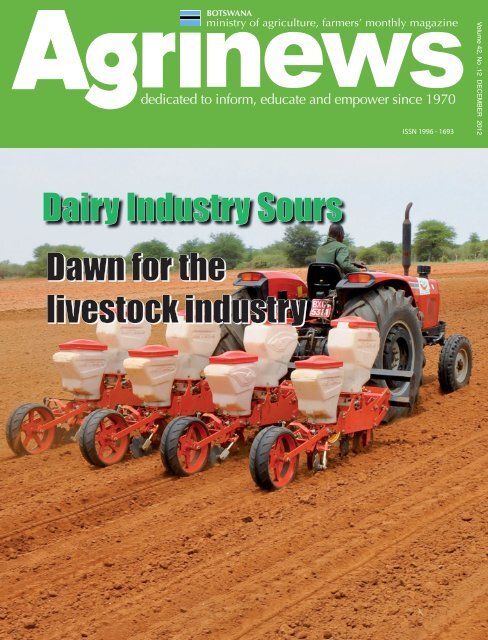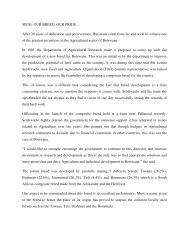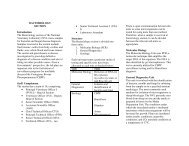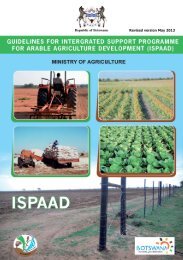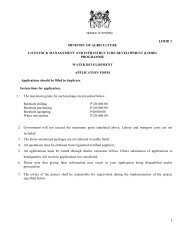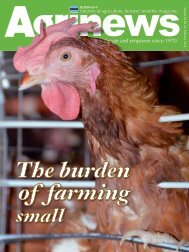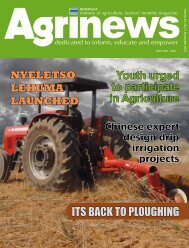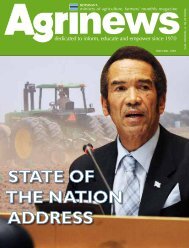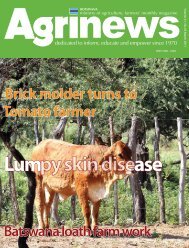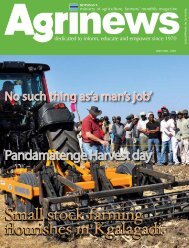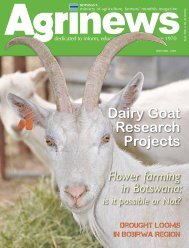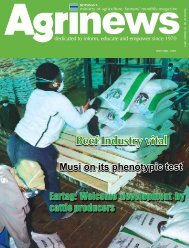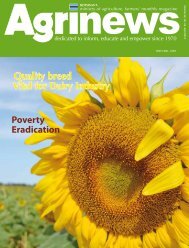Agrinews December 2012 - Ministry of Agriculture
Agrinews December 2012 - Ministry of Agriculture
Agrinews December 2012 - Ministry of Agriculture
- No tags were found...
Create successful ePaper yourself
Turn your PDF publications into a flip-book with our unique Google optimized e-Paper software.
Volume 42, No .12 DECEMBER <strong>2012</strong>Dairy Industry SoursDawn for the LivestockDawn for theIndustrylivestock industry
<strong>December</strong> <strong>2012</strong>
AGRINEWS DECEMBER<strong>2012</strong>ContentsEditorialDrought Scourge in NgamilandNews BriefsFodder ProductionGabriel Musindi Finds Solace in VegetableProductionHorticulture StatusDairy Industry SoursIimportance <strong>of</strong> Fodder Production inBotswanaSmall StockTswana Chickens Way to GoSmall Stock as a Breakthrough AreaHoney ProductionDawn for the Livestock IndustrySeasons Greetings122452621021121221421521621718 219 217521817Moreri MoesiReporters:France BegenselKeamogetse BoitshepoKesog<strong>of</strong>etse TaweleJoseph RamodisaBautule KealatotseMokgarebe MotswakhumoEsther NkgwangModiegi MadumetsaKeabetswe MolebatsiDesigner:Abadilwe RalehikaHead Of PhotographyHenry TotoPhotographers:Pius Nkunda<strong>December</strong> <strong>2012</strong>
VISIONAttain national food securityand global competitivenessin agricultural productsMISSIONTo improve agricultural productivitythrough technology developmentand transfer, diversification andcommercialization, inorder to promote food security inpartnership with our stakeholders.VALUESFOUNDATIONPILLARS1. BOTHOWe treat our customers ina respectable and caring manner.2. TEAM WORKWe recognize the need to work asa team characterized by collectiveeffort, trust, understanding,support and perseveranceirrespective <strong>of</strong> rank or gender.3. CUSTOMER FOCUSEDOur customers are the focus<strong>of</strong> everything we do by beingcourteous, caring, compassionate,tolerant and empathetic.4. INNOVATIVEWe commit to employ new ideasand being proactive in order tomatch the requirements <strong>of</strong> thefuture.HOPE FOR A BETTER YEARWe all agree that theagricultural sector, especiallythe beef sector, was in IntensiveCare Unit (ICU) during <strong>2012</strong>.The closure <strong>of</strong> the BotswanaMeat Commission (BMC) in2011 due to Foot and MouthDisease in Zone 6 and 7coupled with poor rainfall hashad an adverse impact on thesector.Poor rainfall resultedin erosion <strong>of</strong> pastures insome areas, the problemcompounded by overstockingdue to lack <strong>of</strong> lucrative beefmarkets. Lack <strong>of</strong> sales led toamongst others, a drop in beefprices in Botswana. As supplybecame abundant the beefprices drastically dropped. Thisis how the year <strong>2012</strong> can besummed up.However, humanity hasnever despaired as hope iswhat we all have. Perhaps, thatis why God came up with theconcept <strong>of</strong> life after death. Webelieve it is so and continueto live. God gave man hope,and it is through it that all andeditor’s notesundry must live into the NewYear.It will be unfortunate if we wereto welcome the New Year withouthope. Hope that it will rain asforecasted by MeteorologicalServices. Hope that this country,will definitely secure an everlastinglucrative beef market. For aceaseless market will definitelygrow the beef sector.The new year should give us hopeto enable us feed this country. Letus all in the agricultural sectorlive hope and believe in ourselvesthat it can be done. Problems willalways be there even in 2013 andbeyond, but the desire to succeedshould be the driving force.Hope that 2013 will definitely bea good year devoid <strong>of</strong> drought andany other natural disasters. It is thishope that I wish all <strong>of</strong> us to usherin 2013. It is because <strong>of</strong> hope thatwe are tempted to say “ngwaga o osa nthateng kgabaganya…”. Let ustake stock, tighten the screws andsurge forward into 2013.<strong>Agrinews</strong> would like to wishyou a Merry Christmas and aprosperous New Year.5. INTEGRITYWe foster a culture <strong>of</strong> transparency,accountability and dependability.1<strong>December</strong> <strong>2012</strong>
Why is it that there isdrought in Ngamiland?When we talk <strong>of</strong>drought everyone thinks <strong>of</strong> lack<strong>of</strong> rainfall. Indeed there is lowrainfall in Ngamiland but droughtin Ngamiland is different.The area experienced an outbreak<strong>of</strong> cattle Lung disease (ContagiousBovine Pleuroneumonia)in 1995,and all the cattle were killed inorder to contain the disease andlater the area was re-stocked.While farmers were still recoveringfrom the Cattle Lung disease,there was an outbreak <strong>of</strong> Foot andMouth Disease (FMD) in 2007. Asa result, the district never sold itscattle to lucrative markets since2007 to date.Ngamiland cattle are vaccinatedthrice yearly for Foot and Mouthdisease as a control measure.However, the situation worsenedin 2007 when buffaloes andelephants destroyed the FMDfence that restrict cattle movement.At the time, majority <strong>of</strong> vaccinatedcattle, mixed up with unvaccinatedcattle and buffaloes. Since thenFMD became uncontrollable inthe district. It also became evidentthat in search for better pasturesand water farmers moved theircattle from areas with FMD casesto areas without FMD cases. Thisled to the spread <strong>of</strong> FMD in thedistrict especially in subzone2d, which has the biggest cattlepopulation in the district. Out<strong>of</strong> 460 000 cattle in Ngamiland(Zone 2) the subzone 2d makeup to 55% <strong>of</strong> the cattle in the area.The increase <strong>of</strong> cattle in thissubzone without market andwith some cases <strong>of</strong> FMD almostyearly, led to both overgrazing andoverstocking. Farmers moved theircattle from crush to crush lookingfor good pastures, this corrodedpalatable pastures. As a result thescourge <strong>of</strong> drought hit Ngamilandspecifically in Subzone 2d inArticle & Photos: Bautule KealatotseSehitlhwa, Bodibeng, Bothatogo,Toteng, Kareng, Semboyo andMakakong.Farmers in these areas used tograze their cattle in Lake Ngamibefore it was filled to capacity lastyear. Mr. Keletso Selao a farmerat Phathana 2 crush in Sehitlhwaextension area said “the Lake is10km wide and 30km long, hencecovered up the grazing areas,leaving farmers with no area tograze their cattle.” Selao lost over200 cattle due to drought. Anotherdisadvantage <strong>of</strong> the lake filling tocapacity, according to Selao isthat too many cattle come fromfar areas like Kareng, Semboyoand Makakong, to drink water atthe Lake because most farmers donot have money to buy diesel fortheir boreholes.These cattle end up eating sand,plastics, cloths and anythingthey came across. However, themajority died because whenthey drink water they choke fromwhat they had eaten. Selao saidthe death is immediate. Further,he observed that most farmers inNgamiland find it difficult to takeproper care <strong>of</strong> their cattle becausethey are no returns for that. Lack<strong>of</strong> market has demoralized themand left them with no funds to buysupplementary feeds. Selao callsupon other farmers to work handin hand with Veterinary Officersto devise strategies to fight thescourge <strong>of</strong> FMD and build goodrelations as it was before FMD.At the moment , farmers areopting to rear goats which theybelieve can bring back life in thedistrict compared to cattle.The Principal Scientific Officer1 at the Department <strong>of</strong> VeterinaryServices (DVS) in Maun, Mr EusticeDrouin NHandura, said indeed there ispersistent drought in Ngamilandespecially along Toteng to Kukeroad in Subzone 2d. Handuracommented that drought is theresult <strong>of</strong> no vegetation, especiallygrass and shrubs. He concurswith the notion that Lake Ngamiindeed had taken more <strong>of</strong> thegrazing areas.“Due to poor rains in the districtthe water table went down; which<strong>December</strong> <strong>2012</strong> 2
ought ScourgeNgamilandresulted in low yield in mostboreholes. Most farmers have nobuying power since they are notworking and have no market fortheir cattle. Hence fail to sustaintheir folk during this time <strong>of</strong>drought.”Nevertheless, Handura advisedfarmers to buy supplement feedsfor their cattle, especially feedswith high roughage such assorghum brand, grasses. He saidsupplement feeds are better whenthey are fed to cattle startingfrom April to May from Augustto November cattle should befed with more roughage feeds.Farmers should also fight internalparasites which compete fornutrients with their cattle. DVS hasembarked on Livestock AdvisoryCentres (LAC) mobiles to helpfarmers during this period <strong>of</strong>drought.Over 6000 cattle were reporteddead due to drought, this numberwas encountered during farmersreports and number <strong>of</strong> dead cattlephysically seen by Veterinary<strong>of</strong>ficials in the different crushesduring their round up. A moreaccurate figure is expected as<strong>of</strong>ficials continue to compile thenumbers <strong>of</strong> dead catle andhorses.3<strong>December</strong> <strong>2012</strong>0
Compiled : Moreri MoesiNews Briefs <strong>2012</strong>Quote <strong>of</strong> the year;“We cannot feed the naon on idleland,” Minister <strong>of</strong> <strong>Agriculture</strong>, MrChrisaan De GraaffThe year <strong>2012</strong> was a difficult one forthe agricultural sector in Botswana.However, there were also somepockets <strong>of</strong> good news.Botswana Meat Commission (BMC)BMC exports to the lucrave EuropeanUnion market were suspendedfor 18 month to resolve somecompliance issues. Upon resumingexport operaons, BMC recalledover 100 tonnes <strong>of</strong> its beef fromthe E.U because it had Salinomycin.BMC noted that recalling <strong>of</strong> suchconsignments was a normal pracce atthe commission.The New Ultra High Temperature (UHT) PlantThe UHT plant is commissioned inKanye at the Naonal Food TechnologyResearch Centre (NFTRC). It is thefirst <strong>of</strong> its kind to be established inBotswana. The UHT plant is meant toenhance NFTRC’s capacity <strong>of</strong> prospecveentrepreneurs’ viable technologies thatcan be harnessed for promoon <strong>of</strong> agroprocessingand economic diversificaonin Botswana.Pandamatenga Remains the country’sFood BasketPandamatenga amatat farms produced 20000 metric tonnes to complementdepleted naonal stock. BotswanaAgricultural Markeng Board(BAMB) spokesperson, Ms BoipusoNyatshane explained that BAMBused over P40 million to acquire 15000 metric tonnes <strong>of</strong> sorghum fromAustralia. The country consumesat least 90 000 metric tonnes <strong>of</strong>sorghum annually.Poverty datum line declinedMinister <strong>of</strong> Finance &Development Planning, Mr KennethMatambo announced during the <strong>2012</strong>/13budget speech that results <strong>of</strong> the BotswanaWelfare Indicators (Poverty) Survey <strong>of</strong>2009/10 indicate that the number <strong>of</strong>individuals falling below the poverty datumline declined from 30.6% <strong>of</strong> the populaonin 2002/03 to 20.7 percent in 2009/10. Heaributed that to a number <strong>of</strong> factors thatinclude a combinaon <strong>of</strong> sustaining economicgrowth with specific programmes andprojects such as ISPAAD, LIMID, Ipelegengand other poverty eradicaon programmes.Partnership OpportuniesWoolworths Holdings Limited, a companywith more than P4 billion assetsannounces that it is looking for Botswanafarmers to partner with in agriculturalfarming business.Ghanzi District AgriculturalGhanzi District Agricultural show themed“Diversifying the Agricultural Producon- Akey to Food Security and Sustainableeconomic Developments”. This is one <strong>of</strong>the main items in farmers, potental farmersdairies. Mr Cross Kgosidiile, the guestspeaker at the show encouraged farmersnot to let constraints frustrate their desireto help Batswana achieve food security.He called for commercialisaon <strong>of</strong> theagricultural sector.Discussion ForumLetsema 2 focuses on the beefindustry development as the mainexport from the agricultural sector.Milk Sll ScarceThe naonal milk producon hasdropped drascally from record high <strong>of</strong>8.3 million litres per year to 3.1 millionlitres per year as at the end <strong>of</strong> 2011.Outbreak <strong>of</strong> FMDMinister <strong>of</strong> <strong>Agriculture</strong> told residents<strong>of</strong> Gumare that reduced intervalsbetween vaccinaons from sixmonths to four months <strong>of</strong> FMDappears to have more benefits. Hesaid though this is an expensiveundertaking, the strategy seems tobe working.Sunflower ProduconBotswana Agricultural MarkengBoard (BAMB) halts the establishment<strong>of</strong> a sunflower pressing plant inPandamatenga aer realising that anumber <strong>of</strong> private companies had shownkeen interest in establishing such aproject.<strong>Agriculture</strong> Employment StascsParliament told that the agriculturalindustry employs over 6 458 people,according to Stascs Botswana’slabour stascs report <strong>of</strong> 2010 <strong>of</strong> thatfigure 5 413 were Batswana while 1046 were non-cizens.FMD RestockingMinister <strong>of</strong> <strong>Agriculture</strong>, Mr Chrisaande Graaff announces at a pressconference that Red Zones (FMD)infected areas were experiencingoverstocking. Ngamiland hadsurpassed its stocking capacity.Permanent Home for Naonal<strong>Agriculture</strong> ShowThe Naonal show was this year movedto its permanent locaon in SebeleContent farm. The move received loads<strong>of</strong> accolades and was supported by allstakeholders.<strong>December</strong> <strong>2012</strong>
Article & Photos: Moreri ModipeFor many years Batswanahave been involved infood production mainly forhuman consumption. However,in recent years there has been atransformation as some farmersventured in fodder productionfor background before bringingthem into the feedlot which hasa holding capacity <strong>of</strong> 300 cattle.The finishing process entailsfeeding his stock with maizeconcentrate and hay.Within his holding Michauplants mealies throughout theyear to make silage. He however,plans to expand his production infuture by planting beans.Since there is adverse shortage<strong>of</strong> water in Botswana, Michaubeing planted around August/September and harvested around<strong>December</strong>/January then plantagain.During the World Food DayMichau expressed sinceregratitude to Batswana particularlyGantsi residents for theirhospitality. He encouragedBatswana to work hard, believein themselves and pursue theirdreams. Further, Michau isprepared to share his knowledgeJan MichauCattle feeding from Michau’s holdinglike Lucerne, hay, corn and lablab.The potential <strong>of</strong> fodder productionwas recently witnessed by a crowd<strong>of</strong> people who attended the <strong>2012</strong>World Food Day Commemorationin Gantsi. The host farmer, JanMichau is involved in beef andfodder production. He makessilage within his holding and feedsit to livestock which is later soldto different markets.He buys young cattle from localfarmers; sends them to his farmuses drip irrigation to water hiscrops. He has several boreholeswithin his holding and pumpswater with a diesel engine anduses hydrants to disperse it intothe field. Drip irrigation workswell for him in the area wheretemperatures are high and thissystem allows for conservation <strong>of</strong>moisture.So far only eight hectares <strong>of</strong>land is under propagation. Heplants twice a year, the first batchand skills.Michau’s major challenge is thedistance to the slaughter facilitiesthat causes stress to animals.He therefore appealed for theestablishment <strong>of</strong> an abattoir inGantsi. Considering the climaticchanges, Michau expressedconcern about shortage <strong>of</strong> fodderin Botswana. He said measuresshould be put in place to increaseproduction levels.5<strong>December</strong> b <strong>2012</strong>
Gabriel Musindi Finds SolacArticle & Photos: France BegenselMany young men his ageleave the countryside/villages with the hope<strong>of</strong> finding a well paying job inurban areas. Many fall victimto the township circumstances,with some resorting to crime tomake a living. Some <strong>of</strong> themdo not endure a day beforeretracing their footsteps to thevillage.Some young men also believein getting employment andgetting paid at the end <strong>of</strong> themonth. They do not want t<strong>of</strong>all into the uncertainities<strong>of</strong> agriculture, where if itsvegetables, one has to relyon income generated fromvegetables, that do not even getenough water ,from the alreadyscarce commodity. “They say itis a risk not to take,says GabrielMusindi, 27, <strong>of</strong> Lesoma inChobe East. He quotes from asource he can not even identify.To escape the doldrums <strong>of</strong>poverty and unemployment, Musindi decided to go thevegetable way. He says that hefound it hard working for AkunaMathata safaris, disclosing thatwith the meagre wages he got,he could not sustain himselfand his family. He says thathaving worked for six monthsfor the safari company, he quitin 2010 to do a business <strong>of</strong> hisown, where he is his own boss.Besides lack <strong>of</strong> jobs, Musindiexplored the need <strong>of</strong> his villageLesoma, and realised there wasshortage <strong>of</strong> relish especiallyvegetables. He saw potentialin this and decided to makea living out <strong>of</strong> it. He revealsthat sometimes, people had totravel all the way to Kasane andKazungula to buy vegetablesand that he did not want moneyfrom his village transfered.Musindi says that since hestarted production in 2010, henever looked back. And hasrealised a lot <strong>of</strong> pr<strong>of</strong>it especiallyin his first year <strong>of</strong> production. He<strong>December</strong> ODeceOctoberber<strong>2012</strong>121126
ace in Vegetable Productionreveals that in the following year,production was not satisfactorybecause <strong>of</strong> water shortage, butthis year <strong>2012</strong>, things started toimprove. The junior certificateholder attributes all this to theeffects <strong>of</strong> climate change assometimes weather conditionsbecome extreme. He says thatwhen winter comes it is too coldthe same as high temperaturesin summer.He has challenges <strong>of</strong> pests thatinvade his backyard garden. Headds that the most common areAphids and birds. Sometimes,water is also a cause for concernstating that the previous twoweeks (at the time <strong>of</strong> theinterview with <strong>Agrinews</strong>), werenot ones to remember as hiscrops went for days withoutirrigation.For one to prosper in anybusiness enterprise they musthave full interest in what theydo, reveals Musindi. “Theymust also be passionate anddetermined to do well.” Heposits that everyone is gifted, butit is just for one to go out andsearch for what their talents are.He also encourages youthto go out and venture intoagricultural projects, moreso,that the government has rolledout a number <strong>of</strong> initiatives likeLIMID, ISPAAD, Young FarmersFund, CEDA and others. He saysthat Batswana must be able t<strong>of</strong>eed themselves, even export andstop dependency on governmenthandouts. He opines that thereis plenty <strong>of</strong> land and water forpeople to start self sustainanceprojects.Musindi grows cabbages,rape, tomatoes, spinach, choliaamongst others in his backyardgarden. He aspires to one daysee himself owning a big farm,employing a good number <strong>of</strong>Lesoma residents. He started theproject with the little savings hemade when he worked for theSafari company.67<strong>December</strong> m <strong>2012</strong>
HASKINSGABORONTel: 3951200 FPlot 26, NkrumLight Industriwww.haskinIn November <strong>2012</strong>, Haskins Gaborone held a Demo Day where nine selecthe Day was to showcase new products and educate customersLasher displayed and illustrated the durability <strong>of</strong>several <strong>of</strong> their products. Willing customers weregiven a hammer to hit the new polyprop wheelbarrowwith all their strength. The wheelbarrow receivedmany hard blows, with minimal damage. It thereforepassed the test.ADVERTORIALSol<strong>of</strong>elang LungaBenzo-Matic demonstrated their blowtorcheswhich were particularly well received by theplumbers and air-conditioning technicians.Dave Campbell and Steve RoosRicky ToornStihl Chainsaw cutting a log like a hot knife throubutterRennie Chenguiroyen and Aron SibiyaHonda showed generators and water pumpsoperating but the Honda Tiller demonstrationattracted keen interest from farmers. Feedback fromCustomers who have purchased the Tiller is positive,hence all small scale crop farmers should considerpurchasing one.Kago Baitsadi and Hugh Le SueurAaron Selelo, Johan Janse Van Rensburg & Jonathan LotterJohan Meyer and Malcolm WilsonJourney <strong>of</strong> Hope: Our charity <strong>of</strong> the day wasJourney <strong>of</strong> Hope, who helped feed Customers andwere able to raise funds and create awareness forbreast cancer.Unitwist representatives were on sitedemonstrating the ease <strong>of</strong> plumbing with a newpolypropylene 15 mm & 22 mm SABS plumbingsystem.Pferd had many quality grinding and cuttingwhich make light work <strong>of</strong> the steel. Tests ondifferent brands <strong>of</strong> cutting discs were carried outhe technician showed how purchasing a qualityis cost effective, although the initial purchaseis higher.www.haskin<strong>December</strong> <strong>2012</strong>
RONE BRANCH200 Fax: 3949167Nkrumah Rdustrialaskins.co.bwPALAPYE BRANCHTel: 4920300 Fax: 492072KASANE BRANCHTel: 6250123424 Fax: 6250528FRANCISTOWN BRANCHTel: 241230 Fax: 2414298elected Suppliers displayed and demonstrated their products. The aim <strong>of</strong>ers on effective use <strong>of</strong> quality products Haskins Suppliers’ <strong>of</strong>fer.Hitachi and Irwin had a customised truck &trailers, which had many specialised drill machines,electric saws, screwdrivers, demolition hammerrunning <strong>of</strong>f a Honda EG6500CX generator. It alsoexhibited many drill bits and attachments to makethe artisans’ project simpler.MAIN PRIZEWINNERSfe throughLasher garden tools - Mr ChiversEnver CaptieuxHonda tiller in actionHonda Water Pump - Mr Chrispan Gogolautting discsests on theied out andquality discchase priceskins.co.bwDisplays at the demo dayHonda Water Pump – Mr Ramatlapeng<strong>December</strong> <strong>2012</strong>
Article: Keamogetse BoitshepoArticle: Keamogetse BoitshepoHorticulture production isdynamic and ranges fromsubsistence back yard tocommercialized projects. It hasbeen identified as one <strong>of</strong> the fivebreakthrough areas in agriculture.This means that the <strong>Ministry</strong> <strong>of</strong><strong>Agriculture</strong> makes it one <strong>of</strong> thefocal areas to make a significantimpact on a short to medium term.According to the Department<strong>of</strong> Crop Production report for thefiscal year <strong>2012</strong>/13, horticultureproducts national consumption isestimated at 75 000 metric tons.And, the national productiontarget is set at 61.6% <strong>of</strong> the totaldemand which is 46 200 metrictons. The production has by farreached impressive levels with thefirst quarter exceeding the targetand the second quarter comingclose to the margin. Includingthe production <strong>of</strong> first month<strong>of</strong> the third quarter in total 22687.62 metric tons <strong>of</strong> horticultureproducts have been produced. d.ThisNote: This graph reflects production as <strong>of</strong> end<strong>of</strong> October <strong>2012</strong>culminates to more than 50% <strong>of</strong>the total target that is to be reachedat the end <strong>of</strong> April 2013.Backyard Gardens:Most backyard gardens arehorticulture gardens <strong>of</strong> commonvegetables for subsistenceand selling in the locality. Theprojects are in support <strong>of</strong> povertyeradication initiative and havespread throughout the country.Commercial Projects:Horticulture on commerciallevel has grown with more youthand women venturing into fruitand vegetable production atcommercial level. Governmentsupport programmes such asIntegrated Support Programme forArable <strong>Agriculture</strong> Development(ISPAAD) and Youth Funds havemade a significant impact on thesub sector. The contribution <strong>of</strong>government collaborative effortswith financial parastatals such asCitizen Entrepreneur DevelopmentAgency (CEDA) and NationalDevelopment Bank (NDB) cannot go unnoticed. The financialassistance programmes helpedcommercialize most projectsthrough provision <strong>of</strong> loans forstarting up and expansion <strong>of</strong>projects. Local Enterprise Authority(LEA) is also playing a major rolein preparing aspirants beforegetting loans with technical andentrepreneur skills. This guaranteesthat government investment <strong>of</strong>millions does not go down thedrain.To ensure market for locallyproduced horticultural products,importation <strong>of</strong> vegetables and fruitsis strictly monitored to guaranteethat local supermarkets buy fromlocal producers. Also platforms likeBotswana Horticulture Market arein place as a medium to sell localhorticulture products.ISPAAD:Just this year, ISPAAD received80 applications for both individualand group projects. 50 <strong>of</strong> themwere approved and were in totalsponsored by P1, 925 986.08.Not disputing that ISPAAD has itsown limitation, the programmehas remarkably transformed thehorticulture sub sector.Challenges:Inevitably the sub sector haschallenges that pose serious threatto the production level. Some <strong>of</strong>the major challenges include lack<strong>of</strong> crop insurance and effects <strong>of</strong>climate change such as floods,hail storms, frost and extremelyhigh temperatures. Poor cropmanagement and lack <strong>of</strong> continuity<strong>of</strong> production through the year isalso a concern.Interventions:Interventions that are set in placeto curb the challenges include tailormade training programmes andestablishment <strong>of</strong> production cropinsurance. Other efforts includeformation <strong>of</strong> producer associationsand increased share <strong>of</strong> water andland for horticulture.10<strong>December</strong> <strong>2012</strong>10
Dairy IndustrySoursArticle: Joseph RamodisaPhotos: Pius NkundaIn the 21st century, Dairyfarming in Botswana appears tobe at risky as it has never been.While many farmers love the lifethey have and would not wantto do anything else, challenges<strong>of</strong> high input cost and changingweather patterns make dairyfarming a quest that is not for thefaint hearted.For the past 24 months, the milkindustry in Botswana has been afaced with high input cost andlack <strong>of</strong> quality feeds, but for thosewith passion, this scenario can nolonger be allowed to continue.Dairy feeds for the past twoyears have increased by 40%,the situation that forced most <strong>of</strong>the farmers to suspend their dairyoperations.Upon realizing that all is beingdriven to the wall, dairy farmersaround Lobatse invited theVice President, Dr PonatshegoKedikilwe to their dairy farms forhim to get first hand information.This is in away to seek governmentintervention so that this dairyindustry can rise again.The Vice President, whodescribed the dairy industry asone <strong>of</strong> the hanging fruit alsoattributed the poor performance <strong>of</strong>this industry to the high input cost,infrastructure and shortage <strong>of</strong> land.Kedikilwe assured farmersthat the government is aware <strong>of</strong>their situation and has thereforeput new initiative in place tosave the industry, including thedevelopment <strong>of</strong> a Dairy StrategicPlan.“We need the viability in thisindustry.”However, the whole issue hasbeen marked by a series <strong>of</strong> eventsthat has changed the outlook andprospects for the milk industryin this country. High input costand lack <strong>of</strong> quality feeds are thecontributing factors to the lowmilk production in this country,according to farmers visited.Mr. Johannes Schutte, a dairyfarmer at Pitsane said, while thecountry is relying much on theimport <strong>of</strong> milk and its productsit is getting to a stage where theindustry can no longer rise.He said most <strong>of</strong> dairy farmersare now going into the beefindustry because <strong>of</strong> the challengesthey are facing in dairy industry.Schutte was also associating lack<strong>of</strong> water to the poor performance<strong>of</strong> this industry.Consequently, Botswana importmore than 80% <strong>of</strong> the nationaldemand for fresh milk and mostprocessed dairy products.Schutte is positive that this figurecan be lowered if they (dairyfarmers) can be assisted. “I haveequipment, what I want is theblack and white cows,” he said.For the milk to flow, thechallenges <strong>of</strong> bad infrastructure,lack <strong>of</strong> quality feeds and gooddairy breeds must first be overpowered.11<strong>December</strong> <strong>2012</strong>
IMPORTANCE OF FODDER PRIntroductionBOTSWANA FODDERPRODUCTIONLivestock production inBotswana relies almostsolely on forage from naturalrangeland. They graze/browseon natural pastures. Most <strong>of</strong> theproductivity <strong>of</strong> both range andanimals become reasonable duringwet season when range is able toprovide enough nutrients whichincrease levels <strong>of</strong> cows to producemore milk for young ones to growrapidly, also gains weight to activelygain heat, bulls become active tomate efficiently. Animals are able toresist some diseases during this time,subsequently calving percentageand <strong>of</strong>f take are uplifted.However, all these decline in dryseasons because animals scavengefor low quality and quantityroughage. In sandy areas the abovesituation may prolong becausesoils are highly porous whichallows speedy leaching <strong>of</strong> mineralsduring rains hence impend forageto absorb enough <strong>of</strong> them.The condition is worsened bymost livestock producers who areunwilling to produce abundantfeeds to face out subsistence levelfodder production to curtail thesituation. Overgrazing cannotbe over emphasized, becausemost parts <strong>of</strong> this country arebare due to livestock dependenceon natural pasture with less ornone recommended managementstrategies <strong>of</strong> conservationdeployed to reduce deterioration<strong>of</strong> rangelands.The intervention to thatirremediable calamity is to startserious fodder production. Livestockbenefit from the food directly(while flesh eating animals benefitindirectly from grazers). Theseplants also obtain essential mineralsfrom the soil required by animals,hence indirectly benefit throughgrazing, and they are classifiedas macro and micro minerals,depending on whether they arefound greater or less from parentmaterials.(Johnny Rossi) Minerals areessential to livestock nutrition andare classified as macro mineralsor micro minerals, depending onwhether they are found at levelsgreater than or less than 100 partsper million (ppm) in the animal’sbody.MacromineralsThe macro minerals requiredinclude calcium, magnesium,phosphorus, potassium, sodium,chlorine and sulfur.Calcium and phosphateMajor component <strong>of</strong> skeletonGain weightMilk productionQuick pubertyPotassiumBalance base acid in animal bodyTrigger osmotic pressure(flow highconcentrated to low concentration)in animal’s bodyRegulate amount <strong>of</strong> water inanimal’s bodySodium and chlorineProper function <strong>of</strong> nervous andmuscular systems in animal’s bodyRegulate PH and amount <strong>of</strong> waterin animal’s bodyKeep appetite maintained.MagnesiumInduces enzymes for efficientcarbohydrates(C6H12O6)metabolismFormation <strong>of</strong> uniform udder.Nervous system functionsPrevent tetanySulfurPart <strong>of</strong> amino Acids the methionineand cystine which makes protein.Equal amount <strong>of</strong> sulfur assist inmetabolism <strong>of</strong> copper.The micro elements are minorbut still needed by animal’s bodyand most seemed to be abundantbecause they are required in smallamounts. These are iron, manganese,copper, zinc, selenium, cobalt andiodine, chromium, molybdenumand nickel.CobaltComponent <strong>of</strong> vitamin B12Boast appetiteCopperComponent <strong>of</strong> many enzymes<strong>December</strong> <strong>2012</strong>126
PRODUCTION IN BOTSWANANormal growth and developmentInduces fertilityHair pigmentation ( black hair )IodineEssential for minerals absorptionInduces thyroids hormonesfunctionsGoiter regulationIronFormation <strong>of</strong> hemoglobin proteintransport oxygen body systemDark hairManganeseNormal reproduction <strong>of</strong> fetalUdder developmentSeleniumEnhance strong calves at birthIncrease resistance to calf hooddiseasesIncrease libidoZincComponent <strong>of</strong> many enzymesIncrease immunityImproves male reproductionSkins and ho<strong>of</strong> skinsDaily gain <strong>of</strong> weightVitamins help the metabolism andabsorption <strong>of</strong> minerals usually aremet by grazing fresh, green, growinggrass. Drying or overwintering <strong>of</strong>grasses and bad storage cause loss<strong>of</strong> vitamins it is when supplements<strong>of</strong> vitamins are required. Most <strong>of</strong>them are seldom in short becauseare synthesized by bacteria in theanimal’s body (word Web)Vitamin AHelp skins and mucus membranesto stay health.Any <strong>of</strong> several fat-soluble vitaminsessential for normal vision; preventsnight blindness or inflammation ordryness <strong>of</strong> the eyesVitamin DAid the absorption <strong>of</strong> calcium andphosphorus.A fat-soluble vitamin that preventsrickets.Vitamin EA fat-soluble vitamin that isessential for normal reproduction;an important antioxidant thatneutralizes free radicals in the bodyTo neglect fodder production is thesame as dishonoring the principlesfairly stating that to reduce theamount <strong>of</strong> natural range pasture tozero does drastically affect livestocksustenance and cause lot <strong>of</strong> landdegradation through soil erosion.Everyone is aware that to reclaimrangeland which has been degradedto turn it to suitable conditions toprovide animals with enough rangeand pasture for redress, take decadesand is very expensive and communalland lacks ownership or none is heldresponsible.The key to success and interventionto the problems is extensiveproduction <strong>of</strong> Fodder to improveforage and pasture. To achieve thisgoal all livestock producers mustsupplementary feed their livestockand carefully consider the proper way<strong>of</strong> maximizing the benefits <strong>of</strong> fodderproduction. Fodder improvementsinclude;- Use only proven methods <strong>of</strong>fodder production at higher scale tomaximize feeding efficiently throughout the year.- Take improvement <strong>of</strong> fodder as aneed that is compatible to your goalsin livestock investment.- Changes in management practicesthat will be required in livestockinvestment by making fodder/supplements and livestock areentertwined.- Evaluate and impose improvedmanagement is best to benefit bothfodder production and livestock forgood end results and pr<strong>of</strong>itability.- Plans <strong>of</strong> fodder production shouldbe directed to benefit both rangelandand livestock.- Explore all range improvementtechniques at all cost such asintroducing legumes in standing hay,mulcting <strong>of</strong> bare soils, construction<strong>of</strong> ridges, diversion channels,introduction plantation to cover soils.To be continuedPrepared by Godfrey MathumoSub DAPO Letlhakane(Superintendent)gomathumo@gov.bwmathumogodfrey@yahoo.com2978081/2997158030913 613 <strong>December</strong> <strong>2012</strong>0
SmallArticle:: Keamogetse BoitshepoPhotos: Keseg<strong>of</strong>etse TaweleStockThe concept <strong>of</strong> hobby and retirementfarming is slowly fading away. Anumber <strong>of</strong> youths choose to leavetheir lucrative white collar jobs topursuit farming.Nkoketsang Mothobi also left his jobat Debswana to continue a livestockenterprise that he started in 1997.Much as he found farming to be morelucrative, Mothobi also reveals that heprefers investing his youthful energy onsomething that he owns, as opposed toworking for somebody else.After 15 years, Mothobi does notregret his choice as he brags <strong>of</strong> histwo farms, one in Sedudu Ranch andanother Gaedomo Ranch.“I keep small stock and cattle onseparate ranches. Sedudu ranch hasapproximately 550 animals. That is 400goats and 150 sheep while cattle are inGaedomo ranch.”With only a form 5 certificate andexperience in mining, Mothobi taughthimself improved ways <strong>of</strong> rearinglivestock. He practices free rangegrazing system and only provides feedswhen the pastures are dry.“Letlhakane area has good grazingpastures, however when it is dry Isupplement with energy blocks, proteinblocks and diacalcium phosphate.”This Bobonong born and bred sayshe implements strategies that reduceproduction costs. As such makes it apoint that he only buys what he cannotproduce himself. He plants grass andplants to make animal feed such as lablab or silage to feed his animals.Mothobi acknowledged thatlivestock production has small yethigh production costs that are howevercovered in the sale price.“The more I vaccinate and feed well,the more pr<strong>of</strong>it I make. My productsare good and worth the price because<strong>of</strong> their quality. My selling priceincorporates all the expenses I incurredduring growth <strong>of</strong> an animal.”He reveals that the kinds <strong>of</strong> breedsthat he keeps are easy to managein Botswana climatic conditions.He therefore vaccinates for worms,pasturrella and provides vitamin A.Mothobi’s breeds <strong>of</strong> choice are Boergoats, Saneen goats and Dopper sheep.According to him, Dopper has moremeat content and less fur unlike othersheep breeds. It also adapts well to thehot weather conditions.His reasons to keep boer goatsare similar to that <strong>of</strong> Dopper sheep.Mothobi, however said he uses Saneengoats for their milk quantity. He sayswhen goats have more young ones hemilks Saneens for them.“Most breeds are also good and dowell in Botswana. The secret is in theproper maintenance <strong>of</strong> small stock. Forinstance Kgalagadi, Red thrives also inour semi dessert conditions.”Most <strong>of</strong> Mothobiso’s customers arestarting up farmers and those that wantto increase their small stock. He hasnot had a contract with any <strong>of</strong> the bigchain yet, it is still in the pipeline forshort term goals. Agricultural shows arealso a platform to market his business.Mothobi says they have played asignificant role in growing his businessas he gets to show case his products andsell at very good prices at the shows.“Shows have really been a goodmarketing and networking platform forme. Often I get noticed because I winseveral prizes for the animals. The prizeshave a price tag on them and also giveone exposure.”This year alone, Mothobi won sevenprizes at Mahalapye agriculturalshow and five prizes at the NationalAgricultural show. For the latter show,he won champion for senior buck, ewe,does and junior doe.“I make a lot <strong>of</strong> money from sales aswell, I make more than P30, 000.00in shows. My bucks sell at aroundP13, 000.00 each. I some times selleverything I showcase.”<strong>December</strong> m <strong>2012</strong> 14
Tswana ChickensWay to GoArticle & Photos: France BegenselKesol<strong>of</strong>etse Thole’s life changedfor the better, the day sheacquired Tswana chickensthrough the government LivestockManagement and InfrastructureDevelopment (LIMID) programme.For her, it has not been easy sailingfor some years because she hasnever been employed. More soshe had used her chance in theIpelegeng program.Despite the fact that Mabelelands in the Chobe West is floodedwith water for the better part <strong>of</strong> theyear, drought still persists. After thepassing <strong>of</strong> floods, farmers used theland for ploughing especially maize,is no longer beneficial because <strong>of</strong>the effects <strong>of</strong> climate change.Thole who was born 30 years agosays “I have never worked beforebecause there are no jobs in ourvillage. When one is looking for ajob they have to travel all the way toKasane but there are no guarantees.”She adds that she never missesthe agricultural Tv program “TsaTemo Thuo” revealing that this iswhere she learnt about the LIMIDinitiative. She was also inspired byothers who benefited through thesame program.Thole says that unlike others whosay there is delay in the procurement<strong>of</strong> chickens, she cannot complaintabout a thing. She is <strong>of</strong> the opinionthat delays are mainly caused byunavailability <strong>of</strong> chickens but forher it was not difficult getting them.She adds that she got 25 chickensin 2011. Adding that the packageincluded feeds that comprisedmaize, sorghum and sunflower. Shecurrently has 125 chicks which shesays sustain her in her everyday life.Tswana chickens could be asource <strong>of</strong> livelihood for anyonewho is passionate, determined andcommitted to the business saysThole. She says “I can now sell a fewchickens and buy school uniformand pay school fees for my children.I can also buy food from the pr<strong>of</strong>its.”Although this Mabele born’schicken business is a plus, it doesnot go without challenges. Shepoints out that chicken feeds arevery expensive especially thatshe has to travel to Kasane to buythem. She also says that vaccinesare expensive too. And that theyare not readily available from theLivestock Advisory Centre. As suchmost times she is compelled to buyvaccines from private veterinariansat a high price.Thole says that Tswana chickenscan sustain one’s life if takenseriously like any other business.She says that she counts herselfamongst the lucky ones andencourages Batswana to ventureinto agriculture so as to improvetheir lives and create employmentfor others.15 <strong>December</strong> <strong>2012</strong>
SMALL STOCK AS ABREAKTHROUGH AREAArticle: Keseg<strong>of</strong>etse TawelePhoto: Pius NkundaOver the years, small stockproduction has beenperforming poorly inBotswana despite the country havinglarge numbers <strong>of</strong> sheep and goats.Currently, there are approximately 1937 971 million goats and 279 237sheep in Botswana. The performance<strong>of</strong> the small stock industry has beencharacterized by low productivityin terms <strong>of</strong> birth and <strong>of</strong>f take rates.According to the Department <strong>of</strong>Animal production survey the <strong>of</strong>ftake <strong>of</strong> sheep stands at 5.1 %while that <strong>of</strong>goats is 5.7%.The target <strong>of</strong>the departmentis 10 % for bothsheep and goats.The birth rate forsheep and goatsstands at 58.8 and71.1% respectively.ProductionReproduction isa complex processthat is subject tochanges in thevarious stages <strong>of</strong>the reproductivecycle. Small stockproduction inBotswana is facedwith challenges like poor managementplan, health, poor nutrition andlack <strong>of</strong> breeding plans that make itdifficult to quantify the effectiveness<strong>of</strong> reproduction. Moreover lowered <strong>of</strong>ftake is due to the fact that only 2.1% <strong>of</strong>goats and 7.5% <strong>of</strong> sheep in Botswanais under commercial ownership whilethe rest is under communal ownership.Despite low productivity, sheep andgoats populations have grown by 41%and 29% respectively in the recentpast. In addition, the number <strong>of</strong> sheepand goats slaughtered at municipalabattoirs and butcheries increasedfrom the previous year. In the year2009/2010 goats slaughtered were14741 and has increased to 19 781 inthe year 2010/2011 while sheepslaughtered increased from 5 652 to6 206 in the same period.CommercializationHowever, lack <strong>of</strong> organizedmarket has madecommercialisation difficult. Most<strong>of</strong> small stock meat is for homeconsumption and in social ceremonieslike weddings and funerals. Only asmall amount is sold to butcheries,individuals and chain stores. Thishas resulted in the country importingtonnes <strong>of</strong> small stock meat despitethe country having large numbers <strong>of</strong>small stock. In the year 2010 Botswanaimported 179.07 tonnes <strong>of</strong> lamb atthe cost <strong>of</strong> P4 823 792.00 and 48.42tonnes <strong>of</strong> mutton costing P1 080388.00. In 2011, Botswana imported206.27 and 15.22 tonnes <strong>of</strong> lamband mutton respectively. The import<strong>of</strong> live small stock on the other hand,has gradually decreased. The number<strong>of</strong> live sheep imported has decreasedfrom 223 in 2011 to 129 in <strong>2012</strong>,while goats decreased from 435 to249 over the same period.InterventionsThis situation has prompted theGovernment to identifysmall stock industry as animportant breakthrougharea. According to MrBueno Mokhutshwane,government hascome up with someinterventions to try andcommercialize smallstock production. Some<strong>of</strong> these interventionsinclude encouragingsmall stock farmersto start associations,active participation <strong>of</strong>the recently formedSmall stock industryFederation <strong>of</strong> Botswanain order to turn thesmall stock industryaround, establishment <strong>of</strong> database<strong>of</strong> local production and per capitaconsumption, exploiting the potential<strong>of</strong> dairy goats and lamb production.The LIMID component is alsoidentified as the key area to increasesmall stock production. Sinceinception 2709 people have benefitedwith a total <strong>of</strong> 36 541 small stock. Themaximum funds for each beneficiaryis P12 000 <strong>of</strong> which P10 000 is forbuying animals while P2000 is forfeeds.<strong>December</strong> <strong>2012</strong>
HoneyproductionArticle: France BegenselPhoto: Pius NkundaBotswana still imports a lot <strong>of</strong> honeymostly from South Africa and Zambia.The demand for honey stands at 40metric tonnes but only a fraction <strong>of</strong> thatis produced locally. To date since Aprilthis year only three tonnes <strong>of</strong> honey wasproduced from 277 colonies. Low nectasupply is attributed to production beingbelow target.There are a good number <strong>of</strong> Bee farmersassociations who are striving to improve thetonnage <strong>of</strong> honey produced locallyMost farmers keep theirbeehives in apiaries. These areshelters used to protect beesfrom harsh weather conditionsMost <strong>of</strong> the honey found in major retailsupermarkets is imported from SouthAfrica and Zambia. This has promptedthe <strong>Ministry</strong> <strong>of</strong> <strong>Agriculture</strong> to ensureinitiatives are in place to increaseproduction.The table below shows honey production against imports <strong>of</strong> honey since 20062006/2007 2007/2008 2008/2009 2009/2010 2010/2011 2011/<strong>2012</strong>Honey production 5.3 5.9 13.7 13.4 13.2 14.2Honey imports 38.553 26.636 27.286 37.058 24.396 38.737Monetary value (P) 2 850 445* 1 272 524 1 845 440 2 943 599 1 598 940* 3 440 905*17<strong>December</strong> <strong>2012</strong>
Article: Keamogetse BoitshepoPhotos: Pius NkundaThe farming communityhappily welcomed the AnimalProduction Advisory Board as itcarries hopes to enhance livestockproduction industry in Botswana.After years <strong>of</strong> importing geneticmaterial and registering in the SouthAfrican Stud Book, farmers holdprospects <strong>of</strong> locally registering theirbreeders’ societies and schemes formonitoring different breeds.The board was recently inauguratedin Gaborone by the Assistant Minister<strong>of</strong> <strong>Agriculture</strong> Oreeditse Molebatsi.Like its name insinuates the boardwill <strong>of</strong>fer the Minister advisoryservices pertaining to developmentand improvement <strong>of</strong> the livestockindustry. This encompasses mattersrelating to priorities <strong>of</strong> research,development <strong>of</strong> farmed game andgenetic conservation.“This marks one <strong>of</strong> the mostimportant milestones in thedevelopment <strong>of</strong> the livestockindustry in this country,” Molebatsistated.Further Molebatsi said theformation <strong>of</strong> the board is compliantwith the Livestock Improvement Actwhich National Assembly passed inApril 2009. The Act was repealingthe Registration <strong>of</strong> Livestock Act,Cap 36:04 <strong>of</strong> 1921.The 10 membership board bydefault include Dr Phillemon Motsu,Director <strong>of</strong> Animal Production as itsex –<strong>of</strong>ficio member and Joyce Kapelea Chief Scientific Officer in theDepartment <strong>of</strong> Animal Productionas a Registrar. Other eight positionsin the board are occupied by DrL<strong>of</strong>tus Ndzinge as the chair personand Mr Willem Herbst as the ViseChairperson. Other members are DrPatrick Kgwatelala, Dr WameotsileMahabile, Dr Michael Flyman, MrMotshegetsi Senku, Stephen Ghanieand Fredrick Verreynne.Herbst who is also a dairy farmersays the formation <strong>of</strong> the board is anopen door and a life reward for thefarming community.“This means the Minister is readyto give ear to those that are on theground level. As such issues we havebeen meddling with for a long timewill be addressed,” confessed Herbst.According to herbst the farmingcommunity will finally reap rewardsfor their labor to develop betterbreeds for local conditions. Thiscould result in another local breedin no time as farmers’ efforts tobreed have went unrecognized andunsupported, he said.Herbst also celebrated the fact thatthe board combined both farmersand experts in the field. He saidthe combined force is strategic inthat there is will be a balance <strong>of</strong>information sharing.<strong>December</strong> <strong>2012</strong> 18
Re gorotloetsago lebelela thulaganyoya tsa temothuoMosupologo mongwe lemongwe mo BtvBtvThulaganyo e, e tsena metsotso elemasome a mararo morago ga nakoya bosupa. Fa o na le kakgelo kgotsakgakololo mo thulaganyong e, re kopao re leletse mo megaleng ee latelang3689143, 3689113, 3689116, 3689115kgotsa o re kwalele mo email yatsatemothuo@gov.bw<strong>December</strong> <strong>2012</strong>
SORGHUM VARIETYSEPHALAOrigin and DevelopmentSephala is an open pollinated sorghumvariety developed collaborativelyby SADC/ ICRISAT at Matopos,Zimbabwe and the Department<strong>of</strong> Agricultural Research in Sebele,Gaborone Botswana.PerformanceSephala was evaluated and testedon different-location. The researchwasConducted for five (5) years.Plant Characters-An open pollinated sorghum varietySemi-dwarf (135)Early maturity (70days flowering)Cream colored grainsYield potemtial (1.44-3.5/haGood milling qulitiesGood fresh abilityDrought thresh abilityDought toleranceBigger head sizeLess susceptibility to pest<strong>Ministry</strong> <strong>of</strong> <strong>Agriculture</strong>Department <strong>of</strong> Agricultural ResearchSephala is a semi dwarf (135) earlymaturity (70 days flowering) variety.A large semi-compact paniclemedium sized cream-colored grainalsoCharacterizes it.Seed charactersSephala has medium sized creamcoloredgrains a corneous andendosperm.The variety is droughttolerant and is well adapted to mostfarming areas inBotswana.Sephalahas good milling qualities and enduse productPhone: 267-366-8100Email: dar@gov.bw


